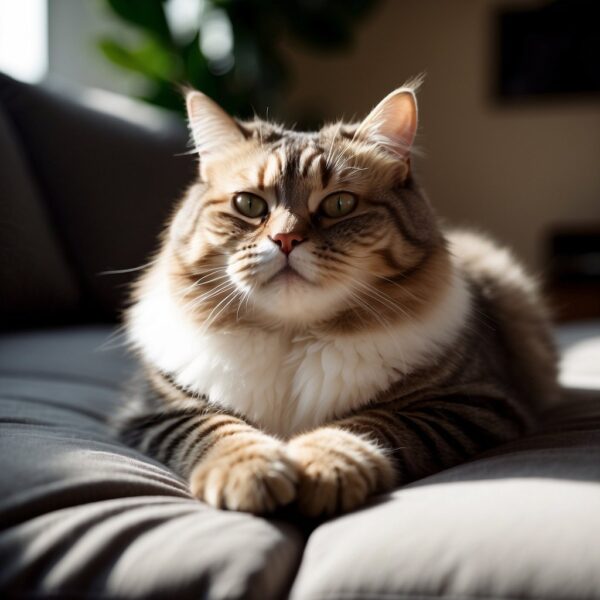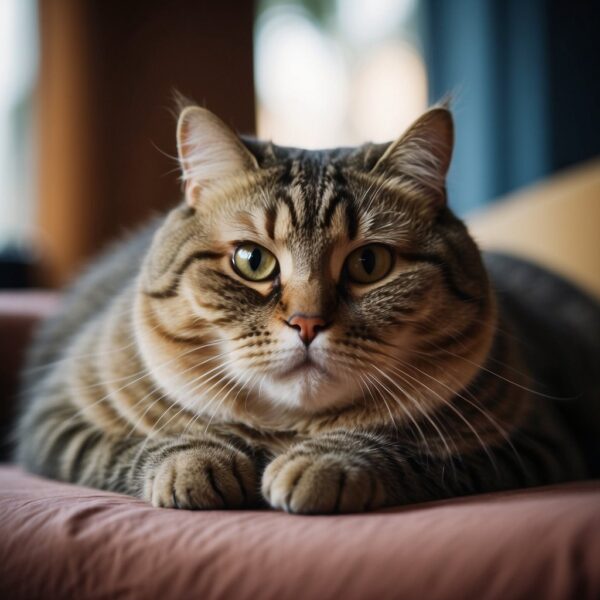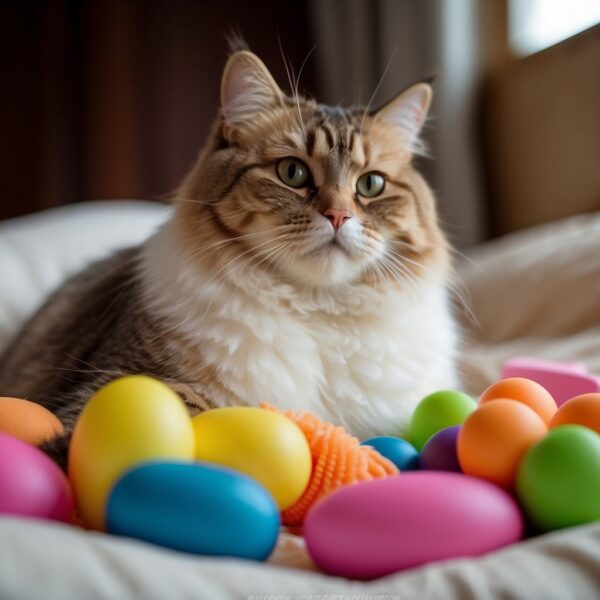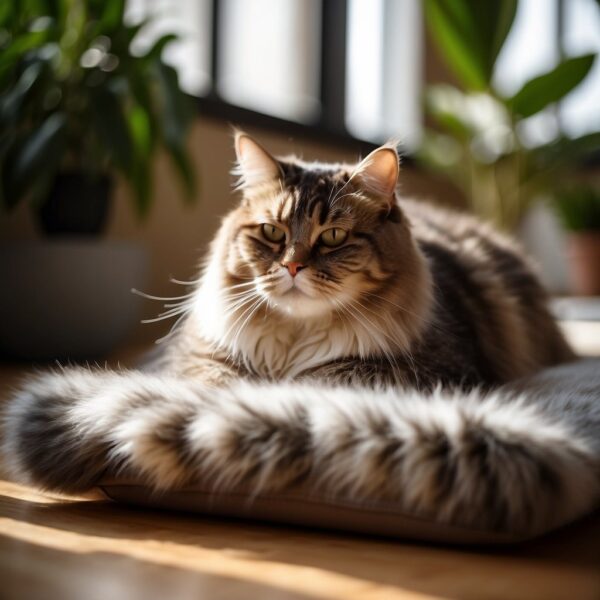
What Is a Chonky Cat?
A chonky cat is an affectionate Internet term for a feline that is significantly rounder or heavier than the average cat. Initially coined and popularized within online communities, the term borrows from the word ‘chunky’ and has become a part of the playful lexicon used to describe pets, particularly cats, who appear cuddly and robust due to their size. While the word itself is a lighthearted way to refer to plump cats, it is essential to consider the implications of a cat’s weight on their health and wellbeing.
The appeal of chonky cats has surged in recent years, with social media and internet culture celebrating the larger-than-life appearances of these furry companions through memes and viral posts. However, the term ‘chonky’ should not be misconstrued as a promotion of feline obesity. The health and wellness of a cat should always remain paramount, involving proper diet, nutrition, and veterinary care to ensure that a cat’s weight is managed safely and healthily. Responsible guardianship entails recognizing when the weight might pose health risks and taking appropriate action to maintain the cat’s quality of life.
Key Takeaways
- ‘Chonky’ is a term used to describe overweight and round looking cats often celebrated in internet culture.
- While endearing, the term should not overshadow the importance of managing a cat’s weight for their health.
- Cat parents are encouraged to ensure correct diet, exercise and veterinary care for their pet’s well-being.

Understanding Chonky Cats
In the realm of internet culture, “chonky cats” have taken social media platforms by storm, leading to a plethora of content dedicated to these amply-sized felines.
Defining ‘Chonk’
Chonk is an internet slang term that refers specifically to overweight or obese cats. This playful variation of the word “chunky” has made its way onto an informal ‘chonk chart’, which categorizes cats based on their weight. The chart ranges from a healthy weight to heavily overweight, with phrases like “A Fine Boi” and the pinnacle term, “Oh Lawd He Comin,” indicating the largest size. While the chonk chart is humorous, it’s essential to remember that a high position on the chart could signal potential health issues for the cat.
Cultural Impact of Chonky Cats
Chonky cats have become a widespread meme across social media platforms such as Facebook, Instagram, Twitter, and Reddit. “This Cat Is Chonky” Facebook group and the subreddit r/chonkers are examples of online communities celebrating these cats. These mediums enable users to share images and videos which typically garners a high level of engagement through likes, shares, and comments. The popularity of chonky cats is emblematic of the wider trend of sharing pet-related content in pop culture, as these felines’ endearing appearance resonates with a large online audience. However, despite the positive attention, it’s important for cat parents to prioritize their cats’ health and not overfeed them for the sake of internet fame.
Health and Wellbeing
The health and wellbeing of a cat can be notably compromised by obesity, which is often indicated by excessive body weight. This section explores the crucial aspects of feline health in the context of “chonky” cats, focusing on identification, associated health risks, and steps toward achieving a healthier weight.
Identifying Obesity in Cats
To determine whether a cat is overweight or obese, a Body Condition Score (BCS) chart is used. The BCS chart typically ranges from 1 (emaciated) to 9 (obese), with an ideal score of around 4 or 5, resembling an hourglass figure when observed from above. A cat is considered obese when its weight is 20% or higher than its optimal weight.
Potential Health Risks
Obesity in cats is linked to an array of health problems, similar to those faced by overweight humans. These issues can significantly affect a cat’s quality of life and may include:
- Diabetes: A higher risk of developing diabetes mellitus due to the body’s decreased ability to respond to insulin.
- Heart Disease: Obstructive and increased workload on the heart can result in severe conditions.
- Osteoarthritis: Joint stress from excess weight often leads to pain and limited mobility.
- Hepatic Lipidosis: A severe liver disease that can occur when an overweight cat loses weight too quickly.
- High Blood Pressure: Associated complications can affect various organ systems, including eyes, kidneys, and the heart.
- Kidney Disease and Cancer: These are other possible health risks exacerbated by obesity.
Achieving a Healthy Weight
To help an obese cat reach a healthy weight, a comprehensive approach is required involving:
- Diet Adjustment:
- Implementing portion control to manage calorie intake.
- Switching to a balanced diet formulated for weight loss under veterinary guidance.
- Increasing Physical Activity:
- Encouraging regular exercise, which can include interactive toys and games.
- Ensuring the cat remains active throughout the day with multiple short play sessions.
Regular veterinary check-ups are essential to monitor the cat’s progress and adjust their weight loss program as needed to prevent rapid weight loss, which can lead to serious conditions such as hepatic lipidosis.

Diet and Nutrition
Managing the diet and nutrition of a cat is pivotal for maintaining a healthy weight and overall well-being. This involves understanding the appropriate feeding guidelines and recognizing the significant role diet plays in weight management.
Feeding Guidelines
Feeding schedules and portion control are critical to prevent overfeeding, which can lead to obesity. A veterinarian can offer the best guidance on both the quantity and quality of food for individual cats. Consistency in feeding routines aids in maintaining a balanced diet. It is recommended to use a measuring cup to ensure the right amount of food is given at each meal.
- Morning Meal: Establish a consistent morning feeding time with measured portions according to the cat’s size and caloric needs.
- Evening Meal: Offer another controlled portion in the evening, maintaining the routine.
The Role of Diet in Weight Management
The quality of a cat’s diet dramatically influences its ability to maintain a healthy weight. A balanced diet containing all necessary nutrients, without an excess of calories, supports overall health. Regular consultations with a vet are advised to tailor the diet as the cat ages or its health needs change.
- High-Quality Food: Select a diet formulated for weight management with high protein and low carbohydrates.
- Regular Evaluation: Periodic veterinarian check-ups are essential to monitor weight and adjust dietary intake accordingly.

Exercise and Environment
Creating an enriching environment that promotes regular exercise is essential for maintaining a chonky cat’s health. Physical activity helps manage weight and supports overall well-being.
Encouraging Physical Activity
Exercise is crucial to prevent health issues in cats, especially those prone to gaining excess weight. Owners should integrate various physical activities into their chonky cat’s routine to keep them active and healthy. Activities include:
- Interactive Play: Use toys that mimic prey to encourage chasing and pouncing.
- Food Puzzles: These require a cat to work for their food, engaging both their body and mind.
- Climbing Structures: Invest in cat trees or shelves to stimulate climbing and provide opportunities for jumping.
- Regular Playtime: Dedicate time each day to play with your cat, which not only encourages exercise but also strengthens the bond between parent and cat.
An environment that encourages movement can have a significant impact on a chonky cat’s level of physical activity and, by extension, their health. Engaging in regular play can help manage a cat’s weight, keeping them more active and preventing obesity-related health issues.
The Role of Veterinary Care
Veterinarians play a critical part in identifying and addressing the health needs of overweight cats. They provide essential preventive care and tailor weight management programs to ensure feline health and well-being.
Preventive Health Measures
Regular Check-ups: Veterinarians recommend that cat parents schedule regular check-ups to monitor the health of their feline friends. During these visits, a vet conducts thorough physical examinations, which can detect early signs of obesity-related health problems such as diabetes, joint issues, and heart disease.
- Dietary Counseling: Vets provide guidance on proper nutrition tailored to the cat’s age, breed, and health status to prevent excess weight gain.
- Exercise Advocacy: They emphasize the importance of physical activity and may suggest ways to increase a cat’s activity level to help maintain a healthy weight.
Treatment and Weight Management Programs
Customized Weight Loss Plans: For overweight cats, vets devise customized weight loss programs that include:
- A structured diet plan focusing on controlled portion sizes and specialized foods.
- An exercise regimen suitable for the cat’s age and physical condition.
Health Monitoring: As cats undergo weight loss, a veterinarian tracks their progress and makes necessary adjustments to their regimen to avoid rapid weight loss, which can lead to other health issues.
- Follow-up Visits: Regular follow-up visits are crucial for monitoring the cat’s response to the weight management program and for providing ongoing support to the owner.
By collaborating with veterinarians, cat parents can help their pets achieve and maintain an optimal weight, supporting their overall health and longevity.
chonky cat Parent Responsibilities
As stewards of their cat’s well-being, cat parents must prioritize their cat’s health through proper nutrition and an understanding of the associated responsibilities.
Understanding the Responsibilities of Cat parents
Cat parents are responsible for the overall well-being of theircats, which includes maintaining a healthy weight. A cat’s health can be adversely affected by both underfeeding and overfeeding. Parents should educate themselves on the nutritional needs of their specific breed of cat. Portion control and a regular feeding schedule are essential for avoiding health issues related to weight. Cat lovers need to provide not just food, but also stimulating environments and regular veterinary care to maintain both mental and physical health.
Avoiding Overfeeding
To prevent overfeeding, cat owners should adhere to the following guidelines:
- Portion Control: Establish a consistent daily feeding amount based on the cat’s ideal weight, age, and activity level.
- Feeding Schedule: Offer meals at regular times each day to help regulate their cat’s appetite and digestion.
Cat parents play a crucial role in their pet’s health and avoiding the trend of celebrating overweight pets. By understanding and adhering to proper feeding guidelines, humans can ensure that the bond between them and their feline companions remains strong and healthy.
Social Media and Chonky Cats
Social media platforms have become a pivotal space for cat enthusiasts to share and celebrate their affection for chonky cats. These platforms foster large communities where images and videos of overweight felines are shared, often going viral for their cute and cuddly appearance.
Online Presence of Chonky Cats
Platforms such as Instagram, Facebook, Twitter, and Reddit are teeming with accounts and pages dedicated to chonky cats. These accounts often feature a cascade of photos and videos showcasing cats with substantial girth and playful personalities. For instance, specific Instagram accounts have gained significant followings by posting content exclusively about chonky cats, celebrating their round figures and charming antics.
Subreddits like r/chonkers have amassed tens of thousands of members, where users frequently post pictures of their pudgy pets, sharing stories and participating in discussions about their care. Similarly, Facebook groups have been created as spaces for cat parents to seek advice, share successes in weight management, and enjoy the lighter side of owning a chunky cat.
Communities Celebrating Chonky cats
The allure of chonky cats extends beyond just sharing images; it has encouraged the forming of communities that actively engage in promoting cat health and happiness. Some online communities on platforms like Facebook and Reddit advocate for the well-being of these animals, discussing diets and health tips to ensure chonky cats live a long, healthy life.
Animal shelters often use their social media presence to highlight the need for adopting overweight cats, employing the term ‘chonky’ to draw attention and find homes for these pets. They provide valuable information about the possible health concerns associated with excess weight, thereby raising awareness among potential adopters.

Frequently Asked Questions
The following FAQs offer insights into the characteristics, care, and health of ‘chonky’ cats, aiming to clarify common concerns.
What qualifies a cat as being ‘chonky’?
A cat is typically considered ‘chonky’ when it exceeds the healthy weight for its breed and body type. This term often refers to an overweight or obese feline.
Are there specific health issues associated with chonky cats?
Larger cats may face health issues such as diabetes, heart problems, and joint pain due to the extra weight they carry. It is essential to monitor their health closely.
What are common behaviors of cats considered ‘chonky’?
Cats deemed ‘chonky’ might show less interest in physical activity, display difficulty in grooming, or exhibit increased lethargy due to their larger size.
How does one effectively care for a cat with a larger body size?
Effectively caring for a larger cat involves proper diet management, ensuring regular physical activity, and regular veterinary check-ups to monitor their health.
What is the lifespan of cats that fall into the ‘chonky’ category?
Cats that are ‘chonky’ can have a shorter lifespan if obesity-related health issues are not addressed. Maintaining a healthy weight can improve their longevity.
Are certain breeds more prone to becoming ‘chonky’?
Some breeds, such as the Maine Coon and the British Shorthair, may be more prone to weight gain due to their build and metabolism, potentially leading to a ‘chonky’ appearance.